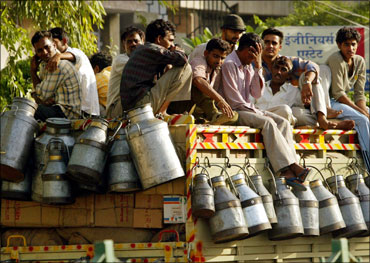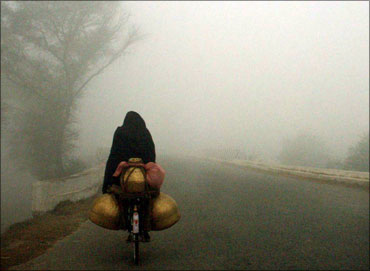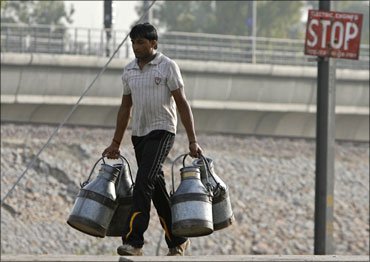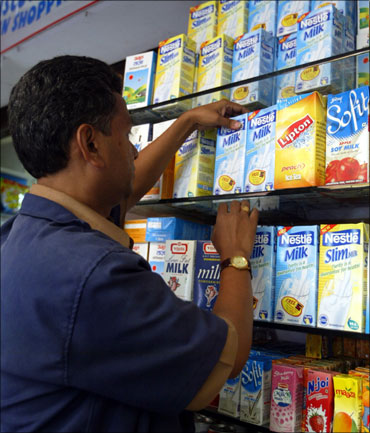 | « Back to article | Print this article |
Rising milk prices: Common man suffers again
Following a hike in the prices of petrol, diesel, gas, milk prices have also gone up.
Between January 2007 and March 2010 the price of milk rose seven times in Delhi. The story is similar elsewhere in the nation too.
In the last one year, prices increased from Rs 17 to Rs 22 a litre. In some cities, like Mumbai, the rise has been steeper. Earlier, it was pulses that were burning a hole in people's pockets; now rising milk prices are making life difficult for the common man.
On a year-on-year basis, the inflation in milk prices has been 21.12 per cent.
Although India is the world's largest milk producer, the demand is projected to grow further in the coming years. Currently, there is gap of 1.8 million tonne between milk demand and supply. This means that an average incremental increase in milk production of 5 million tonne per year is required to fulfil people's needs, as against the annual increase of 3.2 million during the last 15 years.
Click NEXT to read why milk production has dropped. . .
Rising milk prices: Common man suffers again
The drought in north and northwest India in 2009 made things worse. Drought affected the agricultural yield which in turn led to low fodder yield, and increase in prices.
Cost of milk production includes 70 per cent of the fodder; this includes dry wheat, millet or paddy stalks and green fodder.
Apart from this there are concentrates like de-oiled cakes and molasses, among others. The remaining 30 per cent includes medical and labour costs.
Price rise is a fallout of various policies of the government that affect the costs of the entire supply chain and is natural to have a recycling effect on the consumer who is at the end of the link.
The Confederation of Indian Industry believes that given the current situation, the government should take some strong measures to ease milk price pressure and help the smallest stakeholder, the common man.
Click NEXT to find out what some of these steps could be. . .
Rising milk prices: Common man suffers again
Some of these steps could be in terms of:
Short-term measures include:
Increasing availability of fodder.
Provision of improved seed variety for the production of fodder to the farmers. Good quality fodder will fulfill the nutritional requirement of the milch animal which in turn will enhance the productivity per animal.
The slaughter of milch animals for export of beef has to be stopped rigidly.
Medium-term measure can be :
Improving the infrastructure of milk chilling, transportation and processing. This can lead to increase in business and hence lower down operational costs (as leakages would get reduced and added volume will enable per unit costs to come down), improve storage facilities which will help in reducing quantity and quality losses.
Click NEXT to find out what other steps can be taken to ease rising milk prices. . .
Rising milk prices: Common man suffers again
Long-term measures include :
Increasing milk productivity through cross breeding and amplifying the availability of better germplasm for breeding, etc.
Availability of land for fodder cultivation needs to be increased. At present land availability is difficult task and agricultural land available, is being used for production of grains and food but not fodder cultivation. Hence Non agricultural land should be made available to grow more fodder than at present levels.
The result of all these efforts would lead to increase in business, better animal health and prosperity for the stakeholders and eventually reduction in the prices of the end products for the consumer.



